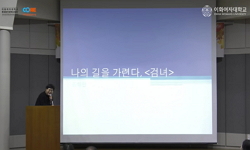예수교 장로회 한국 총회가 처음 열린 1912년 9월 1일 이후로 한국 장로교 신학이 과연 어떤 방식으로 전개 되어 왔는지를 살피는 일의 한 부분으로 이 논문에서는 그 동안의 장로 교 신학이 ...
http://chineseinput.net/에서 pinyin(병음)방식으로 중국어를 변환할 수 있습니다.
변환된 중국어를 복사하여 사용하시면 됩니다.
- 中文 을 입력하시려면 zhongwen을 입력하시고 space를누르시면됩니다.
- 北京 을 입력하시려면 beijing을 입력하시고 space를 누르시면 됩니다.
예수교장로회 조선총회 100년을 돌아보며 : 예수교 장로회 한국 총회 100주년과 한국 장로교 신학의 과제 = One Hundred Anniversary of the First Meeting of the General Assembly of the Korean (Chosun) Presbyterian Church and the Task of the Korean Reformed Theologies
한글로보기https://www.riss.kr/link?id=A99789735
- 저자
- 발행기관
- 학술지명
- 권호사항
-
발행연도
2012
-
작성언어
Korean
- 주제어
-
자료형태
학술저널
-
수록면
90-115(26쪽)
- 제공처
-
0
상세조회 -
0
다운로드
부가정보
국문 초록 (Abstract)
예수교 장로회 한국 총회가 처음 열린 1912년 9월 1일 이후로 한국 장로교 신학이 과연 어떤 방식으로 전개 되어 왔는지를 살피는 일의 한 부분으로 이 논문에서는 그 동안의 장로 교 신학이 제시되어 온 바를 1. 개혁파 정통주의 신학, 2. 신정통주의적 통전적 신학, 3. 신정통주의적 진보신학, 그리고 4. 급진적 진보신학 넷으로 분류하여 검토하는 기초적인 작업을 시도해 보았다. 개개인의 신학이 정확히 어떤 입장에 해당하는 지를 엄격하게 말한다는 것은 어려운 일이나 각 그룹 안에 일종의 신학적 동질성이 있으므로 이와 같은 네 가지 분류가 그리 사실에서 거리가 먼 것은 아니라고 여겨진다. 한국 내에서의 이런 장로교 신학들의 전개를 검토하면서 앞으로 신학이 어떻게 제시되어야 1912년 1차 총회를 모인 그 성경적 전통에 충실할 수 있는 지에 대한 논의로 마무리하였다.
다국어 초록 (Multilingual Abstract)
Since the first meeting of the General Assembly of the Korean (Chosun) Presbyterian Church convened on 1st September 1912 at Pyungyang, the theologies written and developed by Korean Presbyterian theologians are, in the real sense, vary. In this essay...
Since the first meeting of the General Assembly of the Korean (Chosun) Presbyterian Church convened on 1st September 1912 at Pyungyang, the theologies written and developed by Korean Presbyterian theologians are, in the real sense, vary. In this essay I have classified the major trends of Korean Presbyterian theologies as follows: (1) reformed orthodox theologies, (2) neo-orthodox integrative theologies, (3) neo-orthodox radical theologies, (4) radical liberal theologies. It is always difficult to exactly identify one`s theology. Since three are some theological homogeneousness within each of these groups, however, it is not too far from the truth to classify the Korean Presbyterian theologies into these four groups. I concluded with some suggestions about the way in which our theologies can be more faithful to the meaning of the convening the first General Assembly of the Korean Presbyterian Church on 1912. Since the first meeting of the General Assembly of the Korean (Chosun) Presbyterian Church convened on 1st September 1912 at Pyungyang, the theologies written and developed by Korean Presbyterian theologians are, in the real sense, vary. In this essay I have classified the major trends of Korean Presbyterian theologies as follows: (1) reformed orthodox theologies, (2) neo-orthodox integrative theologies, (3) neo-orthodox radical theologies, (4) radical liberal theologies. It is always difficult to exactly identify one`s theology. Since three are some theological homogeneousness within each of these groups, however, it is not too far from the truth to classify the Korean Presbyterian theologies into these four groups. I concluded with some suggestions about the way in which our theologies can be more faithful to the meaning of the convening the first General Assembly of the Korean Presbyterian Church on 1912.
동일학술지(권/호) 다른 논문
-
예수교장로회 조선총회 100년을 돌아보며 : 한국 근대 사회와 장로교회
- 한국장로교신학회
- 오덕교
- 2012
-
예수교장로회 조선총회 100년을 돌아보며 : 한국장로교 총회 100주년 회고 한국장로교의 발달단계
- 한국장로교신학회
- 안교성 ( Kyo Seong Ahn )
- 2012
-
예수교장로회 조선총회 100년을 돌아보며 : 개혁주의 교회의 총회와 신앙고백의 역사: 프랑스 개혁교회 총회와 신앙고백 1559-1620
- 한국장로교신학회
- 김요섭
- 2012
-
예수교장로회 조선총회 100년을 돌아보며 : 한국 장로교 신학의 기원과 형성: 총회 설립 100주년을 즈음해서
- 한국장로교신학회
- 문병호
- 2012




 KISS
KISS






